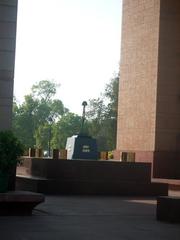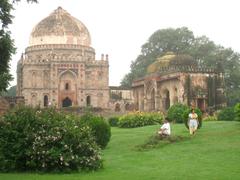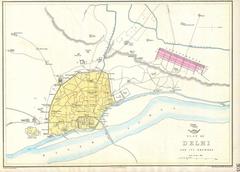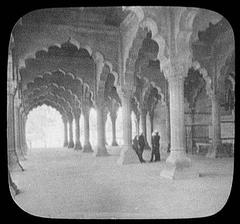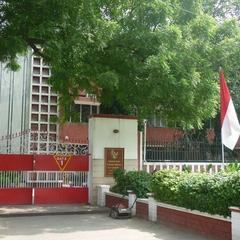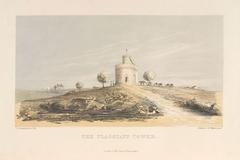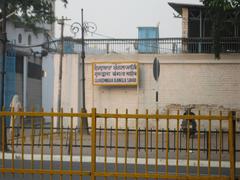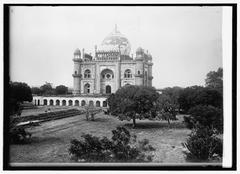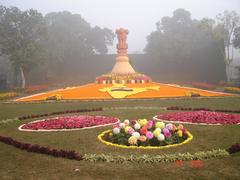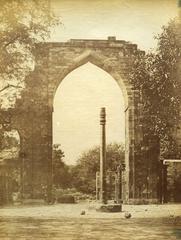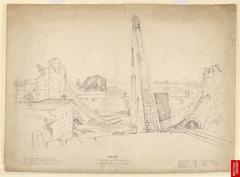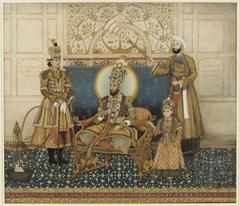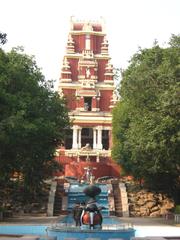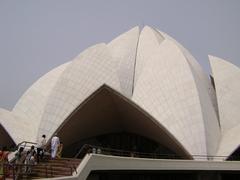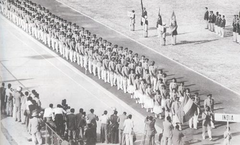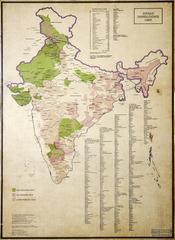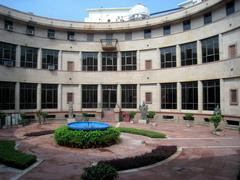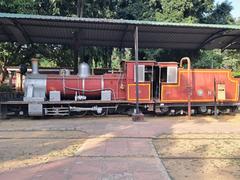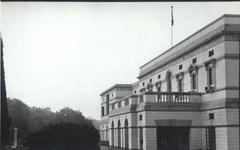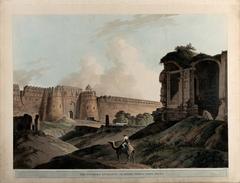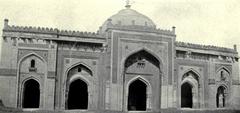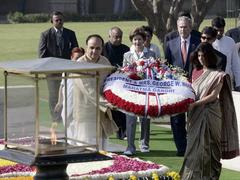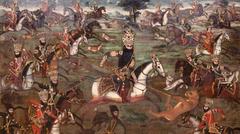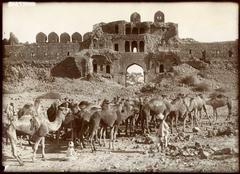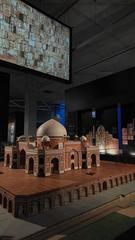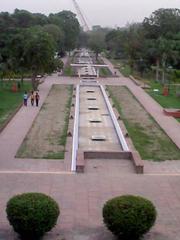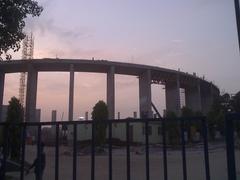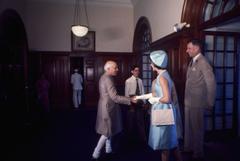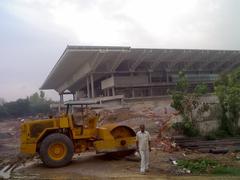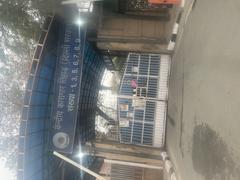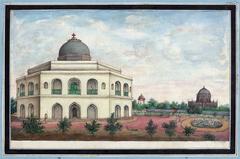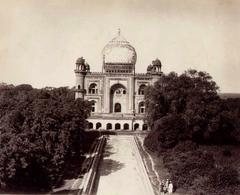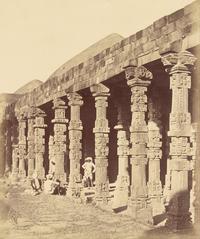Complete Guide to Visiting Tughlaqabad Old City Walls, New Delhi, India: Tickets, Hours, and Tips
Date: 14/06/2025
Introduction: Delhi’s Monumental Medieval Fortress
Tughlaqabad Fort, crowned by its formidable Old City Walls, stands as a powerful reminder of Delhi’s medieval heritage and the ambition of the Tughlaq dynasty. Commissioned in 1321 CE by Sultan Ghiyas-ud-din Tughlaq, this vast fortress was designed to serve both as an impregnable military bastion and the heart of a planned imperial city. Stretching over 6.5 kilometers, with walls up to 15 meters high and 10 meters thick, the fort exemplifies advanced military engineering and urban planning. Its storied ruins resonate with history, legend, and architectural marvels, offering a unique journey into the past for travelers and history enthusiasts alike (Delhi Travel; holidify.com).
Table of Contents
- Historical Context and Significance
- Defensive Architecture and Urban Planning
- Architectural Style and Integration with the Landscape
- Exploring the Fort: Notable Structures and Points of Interest
- Visitor Information: Hours, Tickets & Accessibility
- Travel Tips and On-site Experience
- Nearby Attractions
- Frequently Asked Questions (FAQ)
- Conclusion & Recommendations
- References
Historical Context and Significance
Foundation and Ambition
Tughlaqabad Fort was commissioned by Ghiyas-ud-din Tughlaq in 1321 CE, following his ascent from Khilji military ranks to founding the Tughlaq dynasty (Delhi Travel). The fortress was strategically sited on Delhi’s southern rocky outcrop to repel Mongol invasions and serve as a symbol of dynastic authority (TravelTriangle). Rapidly constructed, the fort was intended as the nucleus of the new city—Tughlaqabad, Delhi’s third historic city (Trawell.in).
The Legend of the Curse
Legend holds that Sultan Ghiyas-ud-din Tughlaq’s conscription of workers from a project led by the revered Sufi saint Nizamuddin Auliya provoked a curse: “May it be inhabited by herdsmen or remain deserted forever.” The city’s abrupt abandonment, shortly after the Sultan’s death and the capital’s move to Daulatabad, lent enduring mystique to the site (Spitfire Gautam).
Decline and Enduring Legacy
Water scarcity, administrative challenges, and shifting political centers led to Tughlaqabad’s rapid decline. The walls, though partially ruined, remain a significant legacy, influencing later Delhi fortifications such as Purana Qila and the Red Fort (Delhi Travel).
Defensive Architecture and Urban Planning
Military Innovations
The fort’s walls, constructed from massive grey quartzite stones and local granite, stretch over 6–6.5 kilometers, with heights ranging from 10 to 15 meters and thickness up to 10 meters at the base (Tour My India; india-a2z.com). Semi-circular bastions and towers offered vantage points, while sloping (battered) walls deflected projectiles. Entrance was controlled by up to 52 gates, of which 13 survive today (Spitfire Gautam).
Urban Layout
The city was meticulously planned with distinct zones:
- Citadel (Bijai-Mandal): The administrative and military command center, placed at the highest point.
- Main City Area: Grid-like layout for residential quarters, markets, and services.
- Palace Area: Royal residences and key administrative buildings.
- Granaries, Stables, and Mosques: Essential infrastructure for sustaining a siege and daily life (jetir.org).
Water management was integral, with stepwells (baolis), tanks, and rainwater harvesting—though ultimately insufficient for the city’s needs (delhipathshala.in).
Architectural Style and Integration with the Landscape
Tughlaqabad’s architecture is marked by power and austerity. Massive stone blocks, minimal ornamentation, and steeply sloping walls dominate the landscape (india-a2z.com). The fort’s irregular ground plan follows the contours of the Aravalli hills, enhancing defense and reducing construction effort (so.city). The proximity of the Asola Wildlife Sanctuary adds to the ecological and visual appeal.
Exploring the Fort: Notable Structures and Points of Interest
- Gates and Bastions: Surviving east, west, north, and south gates showcase the fort’s defensive innovations (Spitfire Gautam).
- Ghiyas-ud-din Tughlaq’s Tomb: A fortified mausoleum, linked to the fort by a causeway and renowned for its domed chamber (MyGate; holidify.com).
- Stepwells (Baolis): Remnants of water management systems that once sustained the city (Tour My India).
- Underground Passages: Some accessible areas offer a sense of adventure and exploration (CN Traveller).
- Panoramic Ramparts: Climbable sections provide sweeping views of Delhi and the Aravallis.
Visitor Information: Hours, Tickets & Accessibility
Visiting Hours
- Standard Hours: Daily, 7:00 AM – 5:00 PM (Agate Travel; india-a2z.com).
- Recommended Season: October to April for pleasant weather; early mornings are ideal for exploration and photography.
Entry Fees
- Indian Nationals: INR 20–25
- Foreign Nationals: INR 100–300 (variation due to different sources and possible updates)
- Children (under 15): Free
Tickets are available at the entrance; carry small cash denominations for convenience.
Accessibility
- The terrain is rugged and uneven; the site is not wheelchair-friendly, and visitors with mobility concerns should plan accordingly.
- Wear sturdy shoes and bring water, especially in warmer months.
How to Reach
- By Metro: Nearest stations are Govindpuri (approx. 5 km) and Tughlaqabad on the Violet Line; take an auto-rickshaw for the last stretch (Agate Travel).
- By Bus: Multiple DTC routes pass near the fort.
- By Car/Taxi: The fort is easily accessible via Mehrauli-Badarpur Road.
- By Road: Ample parking is available; the approach includes a short walk.
Travel Tips and On-site Experience
- Best Time of Day: Early morning for cooler temperatures and dramatic lighting.
- Photography: No extra fees; panoramic and architectural shots are especially rewarding.
- Guided Tours: Local guides are available for a modest fee and can enrich your visit with historical insights (Trans India Travels).
- Facilities: Limited refreshments and restrooms; bring your own water and snacks.
- Safety: The site is generally safe during daylight; avoid isolated areas and stay with groups if possible.
- Dress Modestly: Respect local customs, particularly when visiting adjacent religious sites.
Nearby Attractions
- Ghiyasuddin Tughlaq’s Tomb: An Indo-Islamic architectural gem just south of the fort.
- Adilabad Fort: Another Tughlaq-era ruin, perfect for combined exploration (Travel Triangle).
- Asola Bhatti Wildlife Sanctuary: Popular with birdwatchers and nature lovers.
- Kalkaji Mandir, Lotus Temple, Qutb Minar: All within a short drive, offering diverse historical and cultural experiences.
Frequently Asked Questions (FAQ)
Q: What are Tughlaqabad Fort’s visiting hours?
A: 7:00 AM to 5:00 PM daily (Agate Travel).
Q: How much are the tickets?
A: INR 20–25 for Indians, INR 100–300 for foreign nationals, free for children under 15.
Q: Is the fort wheelchair accessible?
A: No; the rugged terrain makes it difficult for wheelchairs and visitors with mobility challenges.
Q: Can I hire a guide?
A: Yes, guides are available at the entrance and can enhance your understanding of the site.
Q: Are there any photography charges?
A: No, photography is allowed throughout the site without extra fees.
Conclusion & Recommendations
Tughlaqabad Fort’s Old City Walls are a striking testament to Delhi’s rich, layered history. They offer an immersive experience for visitors drawn to tales of medieval ambition, architectural ingenuity, and enduring legends. To make the most of your visit:
- Check current visiting hours and ticket prices.
- Plan your trip during pleasant weather.
- Wear suitable clothing and footwear.
- Consider a guided tour for deeper insight.
- Combine your visit with nearby attractions for a full day of discovery.
For real-time updates, virtual tours, and curated content, download the Audiala app and follow our social media channels for the latest in Delhi’s historical experiences.
References
- Delhi Travel – Tughlaqabad Fort and Its Historic City Walls
- TravelTriangle – Tughlaqabad Fort Overview
- Tour My India – Tughlaqabad Fort Architecture and History
- Spitfire Gautam – Forgotten Walls of Tughlaqabad Fort
- MyGate – Tughlaqabad Fort Neighborhood
- holidify.com – Tughlaqabad Fort Sightseeing
- delhipathshala.in – Delhi Tughulqabad Case Study
- Agate Travel – Tughlaqabad Fort Travel Guide
- Travelure – Tughlaqabad Fort Story


